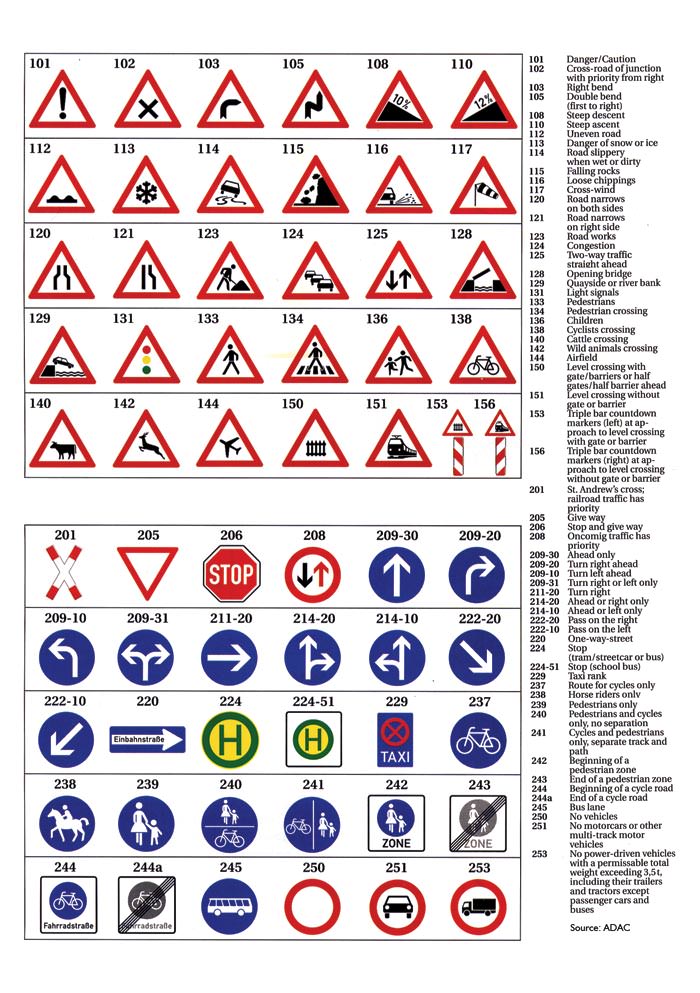Getting a German Driver's License
Your own driver’s license is valid in Germany, at least at the outset. If you’re just visiting and are from outside the EU and EEA and don’t intend to become a resident, you may need to get an International Driving Permit or an official translation of your home country license to carry along with your current license. There are some exceptions to this, so you should check with your local authorities or automobile club about the requirements. And, of course, you have to meet the minimum age for driving in Germany as well as comply with any restriction or conditions on your home country license.
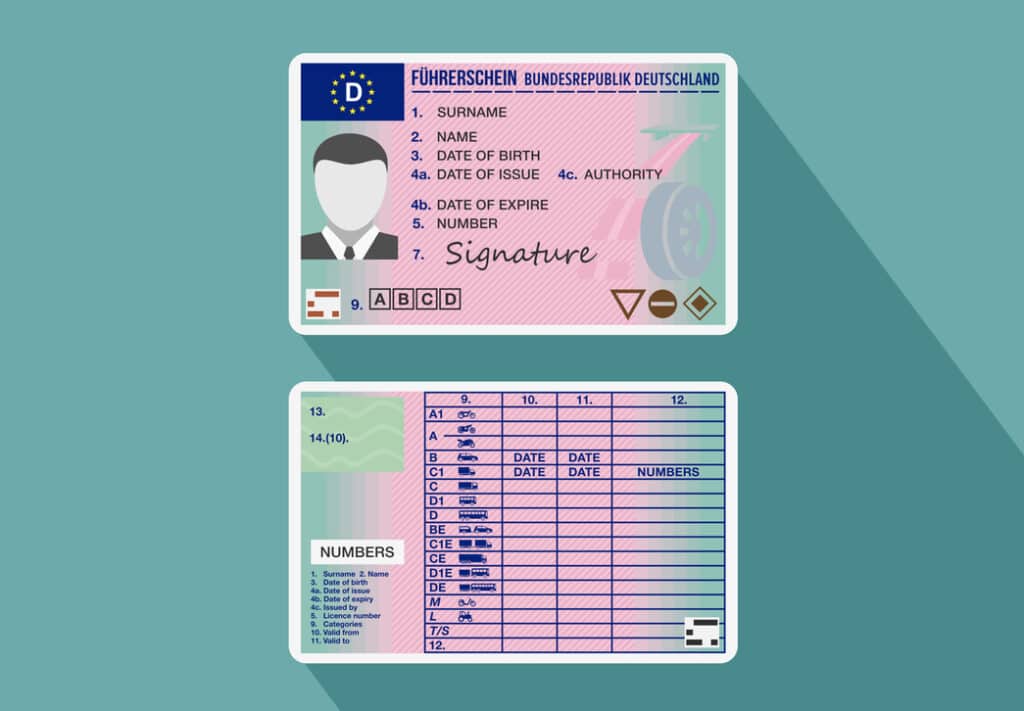
The German driving license. Credit: Nurlankani
If you intend to take up official residence in Germany the following rules apply:
For licenses issued by European Union (EU) countires or the European Economic Area (EEA) member states of Iceland, Liechtenstein, Norway
If your license was issued by a European Union country or one of the EEA member states, it will normally be valid while you are an official resident of Germany until it expires. (You can usually exchange it for a German license before its expiration date.) There may be some restrictions – age, type of vehicles allowed to drive etc. Also, if your EU country license is a translation of a non-EU license, you may have to get a German license after six months. This is an issue you need to clarify with the local authorities.
For licenses issued by countries outside the EU/EEA
If your license was issued by a country outside the EU/EEA, you can only use it for six months from your date of arrival. If you will be residing in Germany for longer than six months but less than one year, you can obtain a six-month extension to use your existing license.
A national of a non-EU country who will be living in Germany longer than a year will need a German driver’s license (Führerschein). In many cases this is a simple matter of exchanging the license for a German one. In other cases it will be necessary to take a written exam, a driving test, or both.
You can simply exchange your license if you come from Canada or the U.S. states of Alabama, Arizona, Arkansas, Colorado, Delaware, Idaho, Illinois, Iowa, Kansas, Kentucky, Louisiana, Maryland, Massachusetts, Michigan, New Mexico, Ohio, Oklahoma, Pennsylvania, Puerto Rico, South Carolina, South Dakota, Texas, Utah, Virginia, Washington State, West Virginia, Wisconsin and Wyoming.
If you come from Connecticut, Florida, Indiana, Minnesota, Mississippi, Missouri, Nebraska, North Carolina, Oregon, Tennessee or Washington D.C. you will need to take the written test, but not the driving test.
In order to get a German driver’s license based on a license from any state in the USA, you must have had your stateside license for at least six months before coming to Germany. The German authorities may ask for some sort of proof of that.
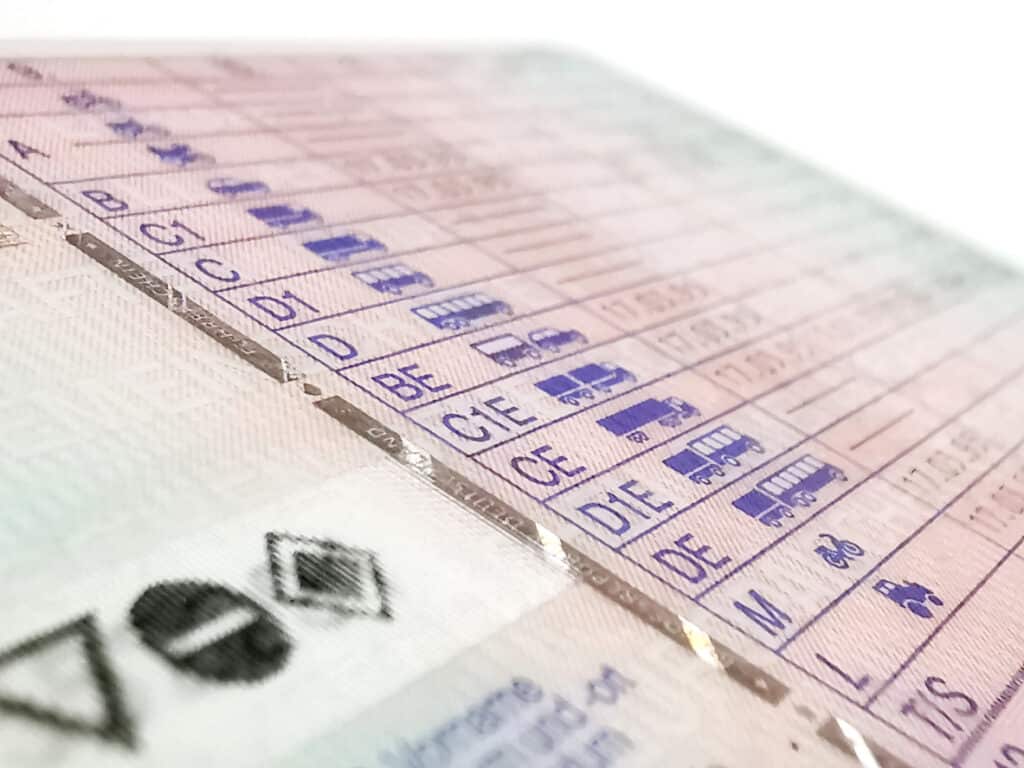
Close-up of the German driving license. Credit: Stadtratte
If your license is from South Africa or any of the U.S. states not listed, you will most likely be required to take both the written and driving examination. If your license is from New Zealand you may be required to take the written examination depending on which classification of license you now hold or wish to get. If you come from Australia you will most likely be able to directly exchange your license for a German one. There may be an extra requirement for a vision test, depending on which territory issued your current license.
To find out the specific requirements for exchanging a license it is best to contact the local authorities.
The written test, which covers such things as rules of the road and traffic signs, can be taken in a number of languages, including English. It’s taken at a drivers’ school (Fahrschule), so let them know in advance what language you prefer. Be warned, the test is tough, and 30% of the people who take it fail to pass it on the first try. So you should study for it. There is a book in English, Lehrbuch Englisch (Fahren Lernen B), that many find a big help. You can buy it from a driving school for about €50, or you may find used copies being offered on line.
The test is multiple choice, but there isn’t necessarily only one correct answer to each question. Some or all of the answers may be correct. You can get an idea of what it is like, in English with the correct answers checked, at www.osterberger.org/test.html.
Fahrschule cars for the driving examination are equipped with dual controls so that the instructor can take over any time the student gets into serious trouble. The law sets minimum durations and mileage for each aspect of the driving instruction: at least 225 minutes and 50 kilometers per session on highways or country roads: at least 135 minutes on the Autobahn with each journey lasting at least 45 minutes, and 90 minutes for driving in twilight or darkness, half of this on highways or country roads.
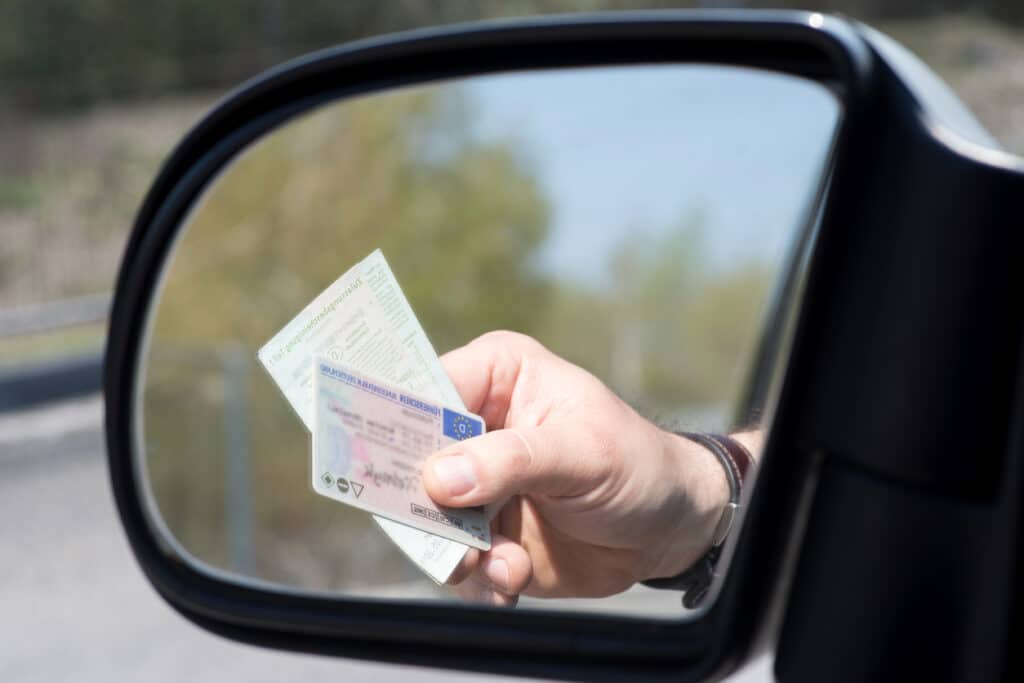
German driving license and car registration. Credit: Stadtratte
Those attending a driving school won’t necessarily be treated as beginning drivers. Many schools have set up simplified courses for experienced drivers, which will cost you about €500 as opposed to the over €1,400 – €1,500 that a beginner would have to pay. If a school tells you it doesn’t offer such a course, find one that does.
The driver’s license is issued by an agency of the local police. To exchange your license you should take it to your local driver’s registration office (Führerscheinstelle). You should have a certified translation. You can get a translation from the ADAC automobile club. (Their office in Hesse charges €36 for members and €46 for non-members.) A person must present an application, a passport, a residence permit (Aufenthaltserlaubnis), two passport-sized photos, proof of attendance at a Fahrschule if required, proof of completion of a first aid course and certification of a vision test which either an optometrist or the Technische Überwachungsverein (TüV) may administer.
Some Americans who work and live in the German states of Hamburg, Hesse, Saxony-Anhalt, Schleswig-Holstein and Saarland may now have it easier. In some cases it may be possible to convert licenses without any written or driving exam no matter what US state they come from. The rules differ somewhat in each of those four German states. In some cases your work must be with an American firm, and in some cases spouses are not allowed to make the simple conversion.
Go to www.amcham.de/services/drivers-license/us-citizens-in-germany.html or check with the local authorities for more information on this and a complete list of the States that have reciprocal agreements with Germany.
This may seem quite a hassle, but once you’ve weathered the storm you’ll have a license that’s good for a long time. All German driver licenses issued before 2013 are valid until December 31, 2032. As of 2013 licenses are valid for 15 years.
For more detailed information on driver’s licenses in Germany you can visit the Federal Ministry of Transport and Digital Infrastructure website page in English.
You can also download these fact sheets from the Federal Ministry in pdf format:
Fact Sheet for Driver’s License Holders from Countries Outside the EU/EAA
Fact Sheet for Driver’s License Holders from EU/EAA Countries
Motor Vehicle Registration, Inspection and Taxes
When visiting the local motor vehicle registry (Autozulassungsstelle) a person needs proof of ownership, proof of insurance and, if the car was purchased in Germany, the Zulassungsbescheinigung Teil II, a document that is supposed to accompany the car through all owners from assembly line to scrap yard. The new or used car dealer from whom the car was purchased will usually handle the registration. If the car was bought from a private seller, the new buyer will have to handle the registration. If the car has been imported and is being registered in Germany for the first time, there are additional requirements that need to be met. See the article on Importing a Car Into Germany.
A vehicle must also pass a safety inspection (HU – Hauptuntersuchung) and emissions control test (AU – Abgasuntersuchung). The safety and emissions tests are conducted by qualified, registered inspectors from a number of companies approved by the government. The companies allowed to conduct the tests include various branches of the Technischer Überwachungsverein (TÜV), DEKRA. Gesellschaft für Technische Überwachtung (GTÜ), and KÜS. Inspectors can conduct the tests at their own facilities or at dealerships and independent car repair garages such as Auto Teil Unger (A.T.U.). Cars that were purchased new must be inspected after three years, and thereafter all cars must be inspected at two-year intervals. When a car passes inspection a sticker indicating the month and year of the next inspection is applied to the rear license plate.
Laws governing the condition of cars and motorcycles are strict. The engine, chassis, frame and all other components, including brakes, tires, horn, wheel alignment, windshield, lights and mirrors will be checked. Vehicles that fail inspection usually do so because of rust or faulty lights, exhaust, brakes or tires. The basic rule is that if an item is mounted on the vehicle, it must function and be completely serviceable even if not essential to operation. Cars imported from outside the EU may require costly modifications to meet the German standards.
Detailed information in English about inspections can be found at the TÜV Nord and DEKRA websites.
Owners of motor vehicles must pay an annual Motor Vehicle Tax to the federal government. The amount of the tax is determined by the age of the car, type and size of the car engine, the type of fuel it uses, and its emissions rating. Click here for more information in English about the Motor Vehicle with a link to a Motor Vehicle Tax Calculator (in German).
Car Insurance
Before a person can register a car in Germany he or she must have proof of third party liability coverage for all damage or injury to another person, car or object. While collision or comprehensive insurance isn’t required by law, most institutions financing the purchase of a vehicle do require it. This can raise the insurance bill considerably, and insurance is not cheap in Germany.
There are numerous factors in addition to coverage that influence the insurance price. Beginning drivers pay more than experienced drivers; those driving big, powerful cars pay more than those with more modest vehicles; those living in urban areas pay more than those in rural areas, and those who have been found liable in accidents pay more than those who haven’t.
If you have a good driving record in your home country you can get credit for it here. Get a letter from your insurance agent back home. If the German agent says you can’t get this credit try another agent. Some insurance agents in Germany are geared to getting the expatriate through these complexities.
For more information on vehicle insurance click here.
For more information on getting a “no-claims bonus” (NCB) from your German insurance provide click here.
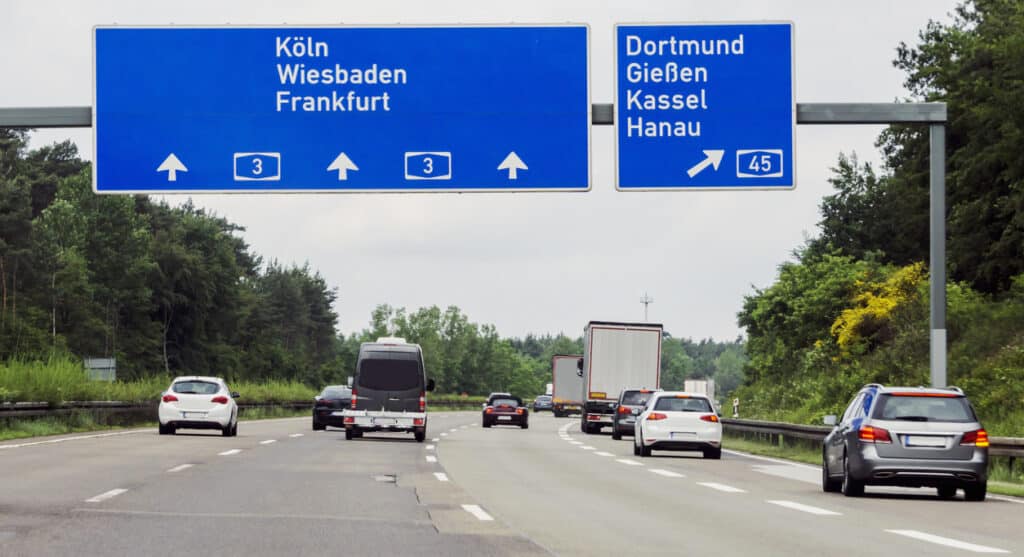
Highway near Frankfurt in Germany. Credit: TomekD76
Traffic Laws
Don’t let the high speeds on German roads fool you into believing that there are no reduced speed zones. There are, in fact, many sections of the German Autobahns that have speed limits. The speed limits are prominently posted in heavily traveled sections of Autobahns around cities. You’ll also see speed limit signs on other seemingly open parts of the Autobahns in the countryside. So, keep an eye open for them. Usually, speeders will not be stopped at the time of the offense but will get a speeding ticket through the mail. This may be as long as two or three months after the incident. The German police use special cameras to catch speeders. Persons exceeding the limits by more than 30 kilometers an hour can count on losing licenses for a period of up to three months, plus a stiff fine. (See the sidebar.)
A tough, computerized point system is used to get dangerous drivers off the road. Increasingly strict penalties are the order of the day especially where drugs or alcohol are involved, and especially if there was an accident. Except where posted because of construction or traffic problems, there are no speed limits on the autobahns, although the recommended maximum is 130kph (about 80mph).
A mixture of slow-moving trucks and high-speed autos are on the same roads at the same time and defensive driving is a must. Autobahn chain-reaction pileups occur periodically, partly because of high speeds. The most common causes of accidents involving expatriates are failing to yield the right-of-way, following too closely and failure to maintain control. Accidents occurring at speeds of over 130 kph on the autobahns can result in insurance payment claims being annulled regardless of who was at fault.
The basic speed limit is 50kph (about 30mph) in built-up areas and 100kph (about 60mph) elsewhere. If you are hauling a trailer the speed limit is 80kph (50mph) on roads and autobahns.
If you see a blinking yellow light at an intersection it means stop, then proceed if the intersection is clear. Run a red light and you’ll probably be caught: many intersections have radar-controlled cameras hooked up to traffic lights.
All vehicles in Germany are required to have serviceable seat belts for all persons in the car, including those riding in the back seat. And the law requires that they be worn. There is a €30 on-the-spot fine for each person in a car not using a seat belt. An exception is made for back-seat passengers in older-model cars that didn’t originally come equipped with rear seat belts. Children under 12 are not allowed to ride in the front seat of a car and must use car seats certified by the German government.
There is no general rule in Germany that prohibits passing in an intersection. The driver making a left turn must therefore check for rear traffic at least twice and, because of the rearview mirror’s “blind spot,” should not rely on it alone.
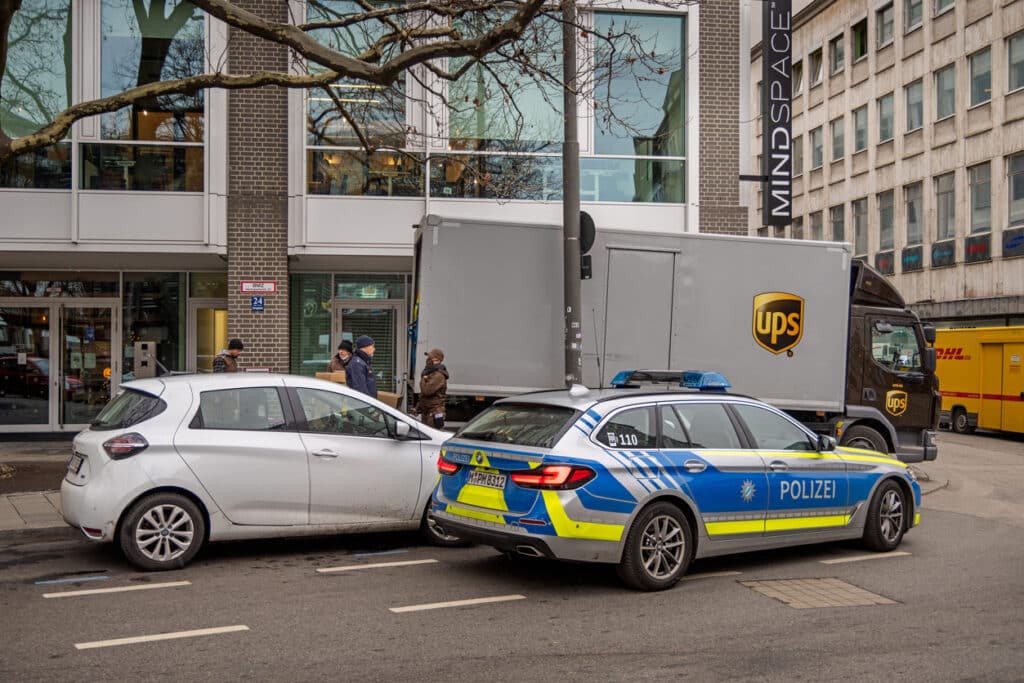
Police sorting out a traffic issue in Munich. Credit: Carstenbrandt
In Germany, a driver can be forced to submit to a blood test. The blood alcohol limit is 0.5 milligrams of alcohol per milliliter of whole blood. Persons exceeding this limit will be fined and face a license suspension of up to three months for the first offense. Just how many drinks it takes to give a person a 0.5 blood alcohol count depends on size and other factors, but two small beers, a quarter of a liter of wine or a jigger of hard liquor will probably get one close.
German law requires that all automobiles have a portable red reflective triangle, first aid kit and a minimum of two safety vests (reflective vests). If a car is stopped for any reason, the triangle must be placed 200 meters behind it if on the autobahn and 100 meters behind it on all other roads. Safety vests should be worn when doing this and whenever outside a disabled vehicle. The car’s emergency flashers should also be turned on. You can only pass vehicles on the left. There’s a stiff fine for passing on the right.
Driving with parking lights alone is prohibited. You must use your headlights (low-beam) at night and during inclement weather. Motorcyclists must wear helmets and drive with the headlight on at all times. The Germans also have a complicated right of way rule. Unless otherwise posted, the driver coming from the right at an intersection has the right of way. Just because you are on what looks to be a major road, you may not be on the “priority” road. A diamond-shaped sign (yellow in the center surrounded by a white border) tells you if you are on a priority road.
The yield sign is an inverted triangle with a red border and white interior and means that you must yield the right-of-way. You don’t have to stop, though, if the way is clear. An eight-sided stop sign means that you must first come to a complete stop before proceeding.
Traffic calming zones (Verkehrsberuhigungenzone), indicated by a sign showing a pedestrian and a child kicking a ball, are often found in residential areas. In them playing children may use the entire street and traffic must stop for pedestrians and move at no more than 7kph.
You must stop for anyone using, or preparing to use, a white-striped “zebra” pedestrian crossing.
Round blue signs with white arrows inside them show permitted directions of travel. For example, if there are arrows pointing both up and to the right it means you have your choice of straight ahead or right, but left is prohibited. If there is a single arrow pointing left it means “left turn only.”
If you’re involved in an accident, do not leave the scene. As the driver of a vehicle involved in an accident you must remain at the scene for at least 30 minutes before leaving, if alone. If you are involved in an accident with others, you must exchange personal and insurance information. Leaving the scene of an accident can lead to severe financial penalties and, depending on whether personal injury to others or extensive property damage is involved, you could be incarcerated or lose your license.
Failure to pay traffic violations (citations for parking in clearly marked “no parking” zones or parking in a handicap space and other relatively small infractions) can lead to imprisonment. If the violations date back far enough and failure to pay is constant, your final payment will be a hefty fine (known as Bussgeld), accompanied by loss of your license and quite possibly a “go straight to jail” card.
Some fines may be collected on the spot, provided the driver has enough ready cash on hand; otherwise, your name and address will be taken and a ticket will be mailed to you later with an accompanying payment slip.
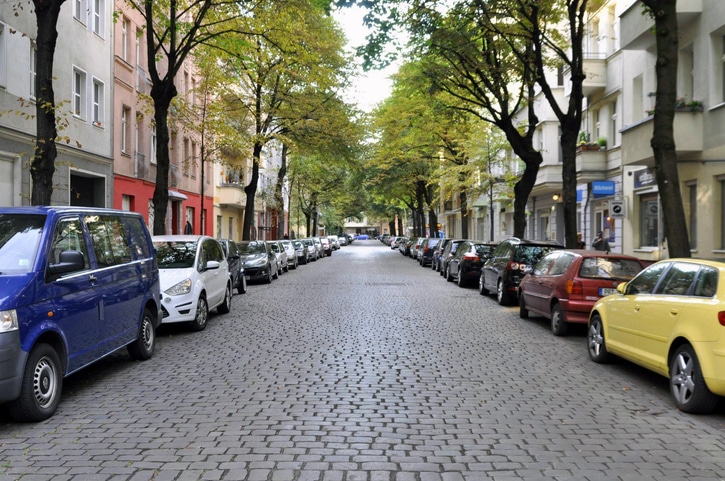
Cars parked on a street of Berlin. Credit: Slava_Andrienko
It is generally difficult to find a place to park during working hours, though in many cases you may be able to park in the evening at places where it’s barred during the day. Be forewarned: German towing fees are very high! Round signs with red borders and a blue interior and an “X” mean no parking or stopping whatsoever. Similar signs with a single diagonal line mean restricted parking, or parking for a limit of three minutes only. Signs with only a red border and white middle mean no vehicles of any type are permitted.
Motorists may not pass a bus that signals with its blinker that it is approaching one of its stops. Once the bus has stopped it’s OK to pass it, but at what the Germans call Schrittempo. That means moving so slowly that the needle on your speedometer doesn’t register. Cars headed in the opposite direction must also use Schrittempo when a bus is stopped with its blinker going. This is because of the danger that people, particularly children, may try to cross the street in an effort to catch the bus. If any do, the car must stop and let them cross.
Driving on snow-covered roads is permitted only if your car is equipped with the proper tires. There are dedicated winter tires as well as all weather tires that may be acceptable. Use of regular summer tires in snowy or icy conditions can result in a fine and, much worse, loss of your insurance coverage in the event of an accident. Check with your local mechanic, dealership or repair shop to make sure you have the proper tires on you car.
Click here for detailed chart of traffic violations and fines in Germany

Emergancy call. Credit: deepblue4you
German Automobile Clubs
Membership in the ADAC (Allgemeine Deutsche Automobil-Club) has a number of advantages. It offers a wealth of information in English, sells insurance, and provides emergency roadside service. Most cities have an ADAC office. The basic fee is €49 a year. You can write or call their head office: ADAC, Am Westpark 8, 81373 Munich. Tel.: (089) 7676-0. Web. www.adac.de
Another club is the AvD (Automobil-Club von Deutschland). It performs many of the same services as the ADAC, including the emergency roadside service, and also carries on Germany’s great automotive traditions. It sponsors the Formula 1 Grand Prix, and a large number of lesser events. Membership is as little as €34.90 per year and the address is Lyonerstr. 16, 60528 Frankfurt/M. Tel 0180 5 164516. Web www.avd.de
Some More Things You Should Know
If you’re involved in an accident, do not leave the scene. As the driver of a vehicle involved in an accident you must remain at the scene for at least 30 minutes before leaving, if alone. If you are involved in an accident with others, you must exchange personal and insurance information. Leaving the scene of an accident can lead to severe financial penalties and, depending on whether personal injury to others or extensive property damage is involved, you could be incarcerated or lose your license.
• Failure to pay traffic violations (citations for parking in clearly marked “no parking” zones or parking in a handicap space and other relatively small infractions) can lead to imprisonment. If the violations date back far enough and failure to pay is constant, your final payment will be a hefty fine (known as Bussgeld), accompanied by loss of your license and quite possibly a “go straight to jail” card.
• Some fines may be collected on the spot, provided the driver has enough ready cash on hand; otherwise, your name and address will be taken and a ticket will be mailed to you later with an accompanying payment slip.
• Good Samaritan laws require that you stop and render aid should you be one of the first to arrive at the scene of an accident.
• Parking – If you live in a German city for any length of time, you soon become very adept at “creative” parking. If you were a poor parallel parker back in the States, when you leave Germany you’ll have a Ph.D. in it! With so many cars now in Germany (over 40 million at last count), and so few parking places, finding a spot anywhere is getting tougher. It is generally difficult to find a place to park during working hours, though in many cases you may be able to park in the evening at places where it’s barred during the day. Be forewarned: German towing fees are very high! Round signs with red borders and a blue interior and an “X” mean no parking or stopping whatsoever. Similar signs with a single diagonal line mean restricted parking, or parking for a limit of three minutes only. Signs with only a red border and white middle mean no vehicles of any type are permitted.
Source: ADAC & Verkehrsdienst Frankfurt am Main
Speeding Fine Calculator
Did you get “blitzed” and expect a speeding ticket to come in the mail? If you knew how much over the speed limit you were going you can go here and calculate your fine. Select the type of vehicle and “Innerorts” if you were driving on city streets or “Ausserorts” if you were on a country road, highway or the autobahn.
Click here for detailed chart of traffic violations and fines in Germany.
German Road Signs
Click image to see it larger
German Traffic Terms
| Abbiegen | turn |
| Abstand | distance (to the vehicle in front of you) |
| Alkohol | alcohol |
| Ampel | traffic light |
| Bahnübergängen | railroad crossing |
| Beschädigung | damages |
| Bußgeld | fine, penalty |
| Drogen | (illegal) drugs |
| Fahrverbot | loss of driving privileges |
| Fehlverhalten | incorrect driving in specified situations; (literally: inappropriate behavior) |
| Fristüberschreitung | inspection or emission control violations (expired inspection stickers) |
| Fußgängerüberweg | crosswalk |
| Geldstrafe | fine, penalty |
| Geschwindigkeit | speed; unangepasste Geschwindigkeit = uncontrolled speed (over the speed limit) |
| gefährliche Überholvorgänge | illegal, unsafe passing |
| Handyverbot | cell phone use prohibited while driving |
| Punkte | points |
| Rechtsfahrgebot | failure to use right-hand lane |
| Rückwärtsfahren | backing |
| Sicherheitsgurt | seat belt |
| Übertretung | Violation (often used with Geschwindigkeit to indicate km above the posted speed limit) |
| Unfall | accident |
| Verkehr | traffic |
| Verkehrsübertretung | traffic violation |
| Verstöße | violations |
| Vorfahrt | right-of-way |
| Wenden | turning |
Aerial view of Oktoberfest in Munich. Credit: Golero
Aerial view of Oktoberfest in Munich. Credit: Golero

